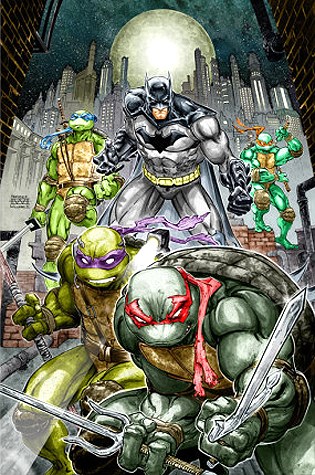Batman / Teenage Mutant Ninja Turtles #1
Written by James T. Tynion IV
Art by Freddie E. Williams II
DC Comics / IDW Publishing
If I were going to write a list of quirky team-ups I wanted to see Batman would almost always be one half of the book.
To mix in the Teenage Mutant Ninja Turtles would have been very high up the list to be the other half.
At first thought the team-up wouldn’t necessarily seem to work.
But that largely depends on how the book would be approached.
There seemed to be two major steps to take in the process. The first is to make sure the version of the Turtles is not Saturday morning cartoon. They had to be drawn and written about with a level of realism matching Batman.
And the story had to ring possible, at least in terms of comics.
Writer James T. Tynion IV manages to give the opening issue of this six-issue run a level of plausibility.
The first step was to have the Turtles finding themselves in Batman’s Gotham, although exactly how remains unknown through the issue.
Next Tynion brings Killer Croc out of the Bat-verse, as almost a rationale for the Turtles being within the realm of possibility. That was a nice touch.
And then there is the great art by Freddie E. Williams II.
The cover is geek-cave quality. I love it.
And there is another large splash with the four Turtles attacking Croc that is about as good as comic art ever gets.
This is one series which held the promise of being special, and through issue #1 it is more than meeting that promise.
Simply a must read for Bat and Turtle fans, and lovers of fun comics with lots of action.
Samurai Omnibus #1
Written by Jean-Francois Di Giorgio
Art by Frédéric Genét
Colours by Dephine Rieu
Titan Comics
Feudal Japan with a hint of mysticism; that pretty much sells me on a book, a comic, a movie, (yes I am drooling over ‘Into the Badlands’ from AMC).
So, to get my hands on Jean-Francois Di Giorgio’s Samurai as a collected edition, it was easy to put into the ‘must read’ file, and very near the top of the cyber pile.
So getting into the book was a pleasure.
The first thing that struck me was Frédéric Genét’s art. Combined with wonderful colouring by Dephine Rieu it is the strongest element of the book.
The Japanese countryside is beautiful, the close in fight scenes filled with action, the grander battles deeming with detail.
You could enjoy this book sans words quite well by just soaking in the art.
Di Giorgio’s writing tells a solid story, although it sometimes misses a beat. The verbal jousting that should come off as funny, rings flat, as an example of just missing the cadence of the moment at times.
That said, the larger story has its intrigue, and captures at least what I have come to recognize as elements of Japan at that point in its history. The ideas of honour to the shogun, and the intrigue of clans forming and dissolving alliances on the chance of a gaining favour and influence come through nicely.
Overall, this is one I’d recommend highly, especially those already with a love of Samurais and sharp swords.




